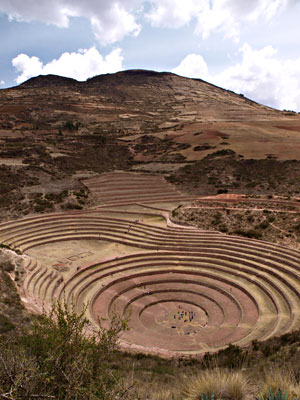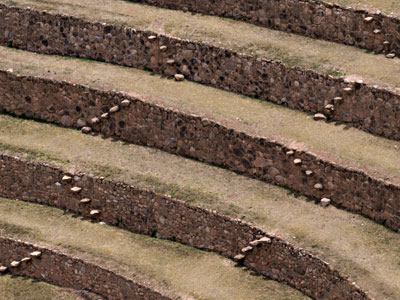 |
| Moray, a multi-level site in Peru with its lowest point 492 feet below the crest of the surrounding hills, is thought to have been the first agricultural experiment station in the world. Photo courtesy of Glenn A. Grube. |
 |
| At Moray, the various terraces have climates similar to those throughout Peru. Photos courtesy of Glenn A. Grube. |
 |
By John Koster
When agronomists want a new potato variety, they go to Peru – and with good reason. The Indian peoples of the Andes, culminating in the Inca Empire, had developed 3,000 types of edible potatoes and 150 types of corn. No one is sure how they did it, but one plausible suggestion is that they did whatever they did at Moray.
Moray is a concave amphitheatre located south of the Sacred Valley and northwest of Cuzco, the ancient Inca capital of Peru, and near Machu Picchu, the “Lost City of the Incas” scientifically discovered in 1911 by Hiram Bingham. Previous explorations by two Spaniards, a Basque, and two treasure-seeking Germans had actually located the ruins of Machu Picchu but saw no great significance to a cluster of overgrown stone walls and roofless houses made of polished stones that were sometimes bigger than a farm wagon and weighed several tons each. Bingham, by giving the small but highly planned city of Machu Picchu a memorable name and describing it in an entire issue of National Geographic, made this the leading tourist venue in South America.
Moray, like Machu Picchu, is more than a little enigmatic. First is its size. The concave hollow in the ground looks like an ancient Greek amphitheatre with a flat mezzanine like the flat tail of an enormous beaver on one side, but the area was clearly not designed for dramatic performances. Its round bottom, started in a natural hollow among the mountains – the Incas always worked in harmony with natural features – is 492 feet below the crests of the surrounding hills. If someone were to put a 50-story skyscraper in the center ring, the penthouse would be level with the mountaintops.
The six central terraces, comprehensively about 100 feet deep, lead to a circular bottom so well drained that it never completely floods, no matter how plentiful the rain. Whether this is due to geologic conditions or man-made tunneling beneath the Moray floor is unknown.
The concentric terraces are split by multiple staircases that extend upward like the rays of the sun and enable people to walk from the top to the bottom of the bowl of Moray. The staircases could be compared to the spokes of a wheel, except that the Incan people, despite their earthquake-resistant construction techniques, apparently never discovered the wheel, although they used log rollers to move giant stones.
Six more terraces, in connected ellipses rather than perfect circles, surround the concentric heart of Moray, and eight terraced steps that cover only a fraction of the perimeter overlook the site. Moray thus has 20 levels of terracing, a dozen in fully connected surfaces in the pit and eight other partial circles between the hills.
What were the terraces for? Low-lying aqueduct channels irrigate the terraces, so they were clearly agricultural. (The Andean people excelled at aqueduct construction, although their stone-channeled grooves in the mountainsides bear little resemblance to the formidable bridge-like structures the Romans made famous.)
The gradual depths of Moray offer another clue. Temperature variations between the lowest and highest terraces span 59 degrees F – representing the difference between coastal sea level farmland and Andean farming terraces 1,000 meters about sea level. The warmest terraces are nearest the circular bottom.
Moray was first recognized as some sort of agricultural site by the 1932 Shippee-Johnson archaeological expedition. Archaeologist John Earls reported that he discovered vertical stones, of a type found in many Incan ruins, to have cast shadows to deduce the arrival of the equinoxes and solstices, important to Andean farmers. Edward Ranney, an explorer and photographer of Andean and American Southwestern Indians, believes that the Incan people used the terraces to raise their most prized plants, including the coca leaves used for both medicinal and sacramental purposes.
The widest consensus, however, is that the pre-Columbian Moray – the name means “dried corn” – was the world’s first agricultural research center, where Incan priest-scientists experimented with wild vegetable crops to determine which should be disseminated for domestic production to farmers with fields all over the Andean region. Pollen samples found in Moray indicate that a huge variety of crops grew there – perhaps not surprising, since about 60 percent of the world’s food crops originated in the Andes, including all known forms of potatoes, the most familiar types of corn, and, of course, the lima bean, named for the Spanish capital that succeeded Cuzco.
“The principal domesticated plants were distributed to their full climatic limits within the area wherever they could possibly be grown,” Wendell C. Bennett and Junius C. Bird wrote in Andean Cultural History, published by the American Museum of Natural History. This diffusion of non-local plants obviously didn’t happen by accident. Bennett and Bird report a well-defined Experimenter Period that began among Quechua-speaking Indians as early as 400 BCE – the great age of ancient Greece and long before the Inca Empire consolidated the Andean tribes into a nation. The period featured innovations such as stone-bladed hoes to replace simple digging sticks, and the first use of llamas as beasts of burden. “In brief, the Experimenter Period is marked by greater dependence on agricultural subsistence, new techniques of cultivation employing terraces and irrigation, experiments with new plants, and the preservation of food,” say Bennett and Bird.
As the Andean tribes were unified many centuries later, during what would have been the later Middle Ages in Europe, ordinary Indians’ lives became regimented to a point that Europeans or Anglo-Americans would have found rather stifling: Incan people were classified by gender, age and profession so much that marriage ceremonies were performed with all the youths and maidens of the same town juxtaposed facing one another in two lines and getting hitched at the same time. Procreation was seen as a vital form of agriculture. The construction of stone buildings for all sorts of purposes was handled in group projects, and stones were set without mortar in a way that walls could shake and rattle without collapsing during earthquakes. Buildings, temples in particular, were aligned in harmony with the solstice and equinox, and the one remaining Inca altar stone not smashed by 16th-century Spaniards vectored on magnetic north. Building an experimental farming station was certainly not outside the reach of the Andean peoples.
The Incas had no written language. But the Inca Garcilaso, the son of a Spanish conquistador and an Andean woman who raised him as a Christian fluent in both languages, left an account of just how regulated Andean agriculture was in the middle of the 1500s, when the Indians retained their entire culture, minus the dynasty.
“The fertilizers they used are different according to the region,” Garcilaso wrote. “In the Cuzco valley and its environs, the corn fields were fertilized with human manure, which the Indians considered to be matchless for fertilizing this particular plant … where it is too cold to grow corn, the potato fields, which extended over more than one hundred and fifty leagues of land, were enriched with animal manure.
“… Along the entire coast … a distance of over two hundred and fifty leagues, the only fertilizer used was that of seagulls … islands not far from shore are covered with such quantities of their droppings that they look like mountains of snow. Under Inca rule, the birds were protected by very severe laws; it was forbidden to kill a single one of them, or even to approach their islands during laying season, under penalty of death.
“… in the other coast provinces … the fields are manured with the heads of sardines …”
The Incan culture, intensely preoccupied with making the best use of every acre of ground for the best possible food, had the organizational skills and, apparently, the knowledge to nurture the most productive crops for each successive climate belt of the steep Andean fields. Only a signed statement is lacking to prove beyond a doubt that Moray – “dried corn” – was an agricultural experiment station long before the days of George Washington Carver or Luther Burbank.
About the author: John Koster is the author of Sneak Attack and Custer Survivor.
